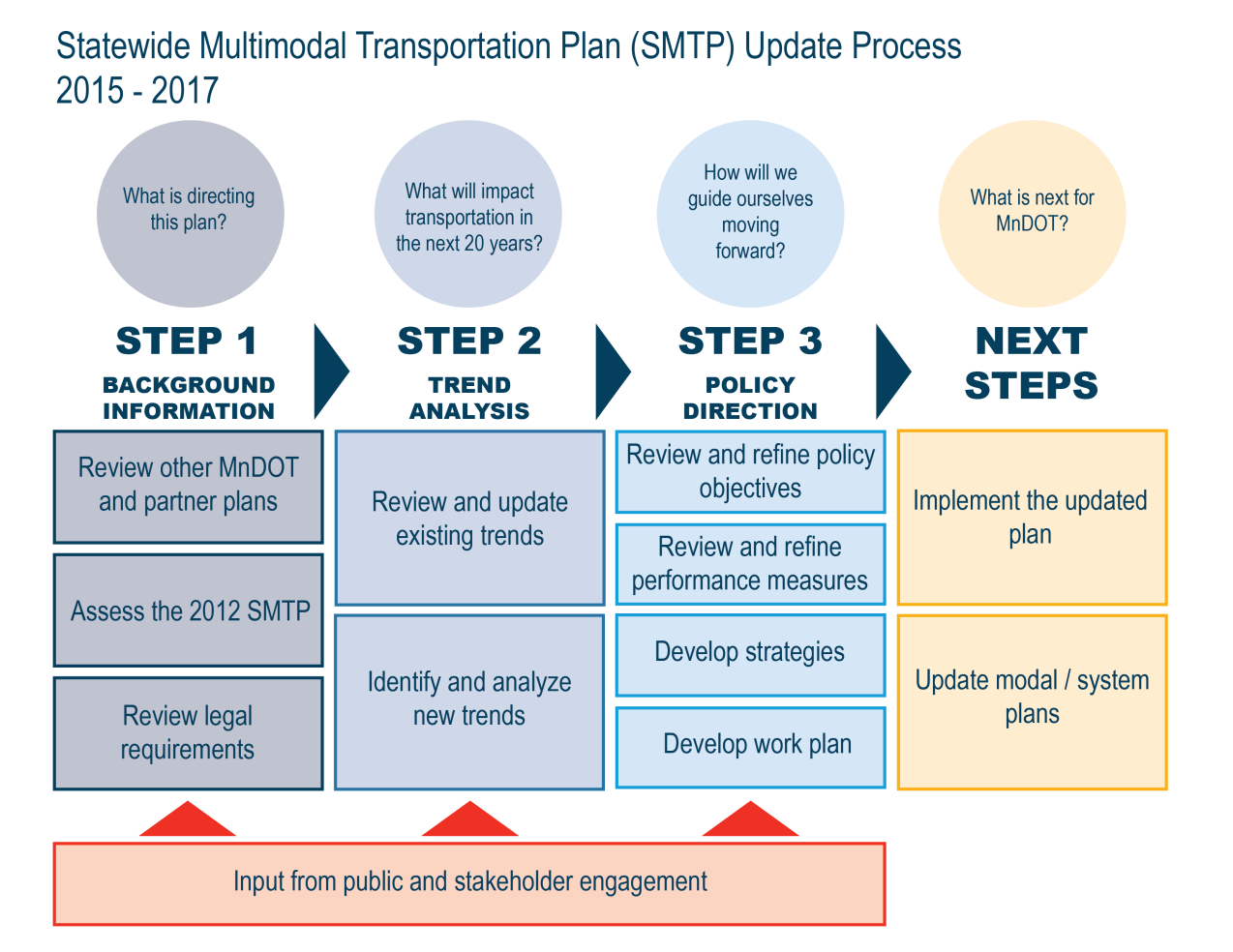Introduction – What is the SMTP?
- No related sections.
The Statewide Multimodal Transportation Plan
The Statewide Multimodal Transportation Plan is Minnesota’s highest level policy plan for transportation. It is a 20-year plan based on the Minnesota GO Vision for a transportation system that maximizes the health of people, the environment and the economy. The plan is for all types of transportation and all transportation partners. It is about more than just roadways and more than just the Minnesota Department of Transportation. It evaluates the status of the entire transportation system, takes into account what is changing, and provides direction for moving forward over the next 20 years.
Plan Update Process
MnDOT is required by state and federal law to plan for 20 years into the future but also to update the plan every four years. The SMTP was last updated in 2012. The update process, as shown in Figure I-1, consists of three steps.
Figure I-1 Statewide Multimodal Transportation Plan update process

- Baseline Assessment: The process began with a review of other MnDOT plans and plans from transportation partners. It also included a review of the changes in law and policy since the plan’s last update in 2012. Information was collected about what MnDOT and other transportation partners are currently doing and what is already planned for the future. Finally, MnDOT evaluated the progress made so far in implementing the 2012 SMTP. More information from the baseline assessment is available in the Appendices.
- Trend Analysis: The next step focused on how Minnesota’s population, economy, environment, transportation behavior and technology are changing. It included reviewing the recent past, making educated guesses about the future and analyzing what the future changes might mean for transportation in Minnesota. Chapter 3 provides a summary of this trend analysis. During this step, Minnesotans prioritized the trends based on how important it is for MnDOT to plan for the changes and suggested potential responses. A summary of input is included in Chapter 4.
- Revise Policy Direction: Using the baseline assessment, trend analysis and input from the public and partners, MnDOT updated the objectives and strategies of the 2012 SMTP. Additionally, key performance measures were identified for each objective. The updated objectives, performance measures and strategies are listed in Chapter 5. A near-term work plan for MnDOT was also developed. The work plan includes a list of activities MnDOT will do in the next four years and can be found in Chapter 6.
WHAT IS A HEALTH IMPACT ASSESSMENT
A health impact assessment for the SMTP update was conducted by the Minnesota Department of Health in collaboration with MnDOT. The HIA focused on changes to policy direction related to the plan objectives of transportation safety, critical connections and healthy communities (see Chapter 5).
Generally speaking, an HIA is a tool to help uncover connections between proposed policies, plans or programs and the impacts on community health. Through its six steps, an HIA can help inform decision-makers before direction is finalized by making evidence-based recommendations. An HIA is one tool that can be used to advance health in all policies and equity.
For more information on MDH’s HIA of the SMTP, visit www.health.mn.gov/mnhia.
Throughout the entire update process, MnDOT sought input from the public and transportation partners. A summary of the input received is included in Chapter 4. A detailed report of the public engagement activities is available in Appendix D.
Additionally, The Minnesota Department of Health conducted a Health Impact Assessment on the objectives and strategies drafted in Step 3. The MDH report provided suggestions on how to strengthen the connections between transportation and public health. A link to the final assessment is available in the "Want to Learn More?" section of the Appendices
Family of Plans
The SMTP provides a framework for a full set of statewide transportation plans. MnDOT plans for all the ways people and goods move throughout Minnesota—individually for each mode and together as a multimodal system. The SMTP identifies overarching guidance and priorities for the entire transportation system. The other statewide transportation plans offer mode-specific strategies, guidance, and investment priorities for each part of the system. These plans include aviation, bicycle, freight, highway, pedestrian, ports and waterways, rail and transit. Additional plans provide more detail related to safety, accessibility, operations, technology and more. Together the “family of plans” directs investments, maintenance, operations, modal programs, and services for the all types of transportation.
Partners
Implementing the strategies identified in this plan requires partnerships. Transportation planning involves private partners and all levels of government. Some partners are responsible for the delivery of the system. Others are responsible for providing input, either technical or advocating for a specific interest. The key partners that will help implement this plan include:
- Transportation partners – Everyone responsible for the delivery of Minnesota’s transportation system. This includes local, regional, state, tribal, federal, private sector and non-profit partners related to all modes of transportation.
- Local partners – Agencies and organizations responsible for transportation systems and decisions at the local level. This includes cities, counties, townships, public transit providers, ports, and airports.
- Regional partners – Metropolitan planning organizations and regional development organizations. When it comes to transportation, regional partners are primarily involved in the planning and programming of projects. However, there are different levels of involvement, responsibilities, and requirements for different regional partners. Regional partners are also often involved in related planning activities such as economic development, land use, etc.
- State partners – All state agencies and organizations in Minnesota with a statewide mission and transportation interests or impacts. Key state partners include the Minnesota Department of Employment and Economic Development, the Minnesota Department of Agriculture, the Minnesota Department of Health, the Minnesota Housing Finance Agency, the Minnesota Department of Public Safety, the Minnesota Pollution Control Agency, the Minnesota Department of Natural Resources, the Minnesota Environmental Quality Board, and Explore Minnesota Tourism.
- Tribal partners – The 12 sovereign nations of American Indian peoples with jurisdiction over lands and resources within Minnesota: Bois Forte Band of Chippewa, Fond du Lac Band of Lake Superior Chippewa, Grand Portage Band of Lake Superior Chippewa, Ho-Chunk Nation, Leech Lake Band of Ojibwe, Lower Sioux Community, Mille Lacs Band of Ojibwe, Prairie Island Indian Community, Red Lake Nation, Shakopee Mdewakanton Sioux Community, Upper Sioux Community, and White Earth Nation.
- Federal partners – Agencies that provide funding and have policies that impact the delivery of the transportation system. This primarily includes the U.S. Department of Transportation’s Federal Aviation Administration, Federal Highway Administration, Federal Railroad Administration, and Federal Transit Administration. Other federal agencies such as the U.S. Environmental Protection Agency, Department of Housing and Urban Development, Department of Commerce/Economic Development Administration, U.S. Army Corps of Engineers, and the U.S. Fish and Wildlife Service also impact transportation decisions.
- Private sector and non-profit partners – Transportation advocates, developers, chambers of commerce, construction companies, consultants, and private industry. Developers play an important investment role in bringing new transportation infrastructure to Minnesota communities. Private industry partners include railroads and other shippers and carriers.
In addition to the partners identified above, many boards, committees and councils contribute to transportation decisions. State and federal legislators, community leaders and the general public are also active participants in the state’s transportation system.
Overview of the Plan
- No related sections.
The plan is divided into six chapters. The following is a brief summary of each.
Chapter 1 “What are we trying to achieve?” sets the scene with the Minnesota GO Vision for transportation. It outlines what Minnesotans said they want for their transportation system now and in years to come. This is the long-term goal toward which all transportation plans should lead.
To achieve the Minnesota GO Vision, it is important to know the starting point. Chapter 2 “Where are we now?” discusses the state of the state. It describes the existing transportation system, its use and condition, and how each type of transportation is funded.
To effectively plan for the future, it is important to understand how things are changing. Chapter 3 “What is changing?” describes key trends in Minnesota’s population, economy, environment, transportation behavior, and technology.
Thousands of Minnesotans contributed to this plan. Chapter 4 “What is directing this plan?” briefly describes the public engagement activities. It also highlights the feedback the public and partners provided on trends and key policy questions. It includes information on the recent history of transportation planning in Minnesota and how changes in policy and law affected this plan.
With this context on the past, present and future, Minnesota can effectively plan for the state’s transportation system. Chapter 5 “How will we guide ourselves moving forward?” presents objectives, performance measures and strategies that will guide Minnesota toward the Minnesota GO Vision over the next two decades.
Chapter 6 “What is next for MnDOT?” outlines steps MnDOT will take to advance the plan's objectives and how progress will be tracked. This includes a near term work plan which describes key actions for MnDOT to complete before the plan is updated in four years. The chapter also outlines how this plan will influence MnDOT’s other statewide plans, capital programs and operating plans.
Finally, a set of Appendices provide additional information and analyses that guided the development of this plan.
